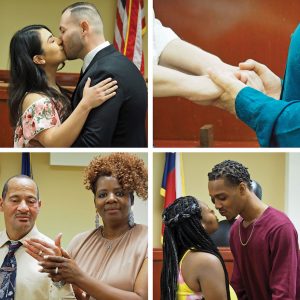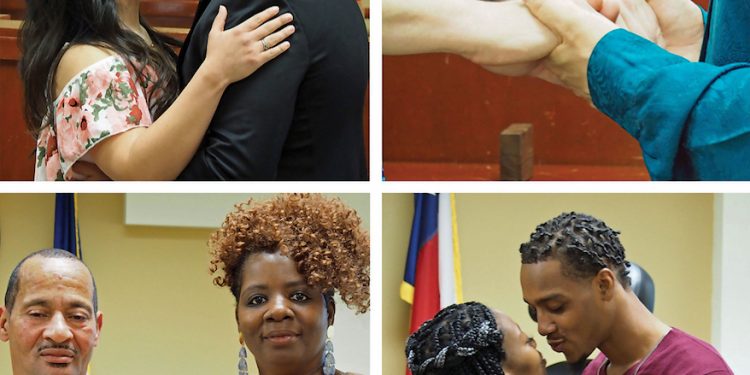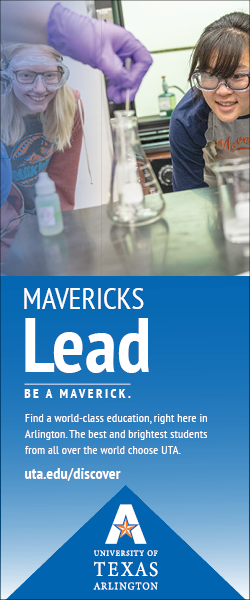
If it’s Friday at Justice of the Peace Mary Tom Curnutt’s office on East Abram Street, she knows that once again it’s wedding day.
The justice of the peace office is often referred to as the people’s court, so it catches a mish-mash of legal issues; school truancy and highway patrol tickets. Tenant disputes, towing cases, small claims and more.
And, clearly, marriages. Lots of them.
They’re mixed almost seamlessly into the court’s other business and can take place any day the court is open – except that mostly they occur on Friday. The average that day is nine to a dozen vow exchanges, though it can be considerably more.
“Valentine’s Day fell on a Friday a while back, and I ended up with 32 marriages, the record for a day for us,” Curnutt says. “It’s usually busiest when the following Monday is a holiday – sort of a long weekend honeymoon, I suppose.”
Curnutt, 52, and a fifth generation Arlingtonite, has held the office for almost seven years but notes that when she was considering running for the office, she studied everything about it. Or almost everything.
“Except for weddings,” she says. “I confess that part of the job was just something I didn’t give a lot of thought to.”
But she soon discovered that performing marriages came with the territory, and she’s become proficiently efficient at the task while still maintaining a warm ambiance. Mostly, it takes five minutes for setup, another five for vows and another five for post-ceremony instructions. Curnutt’s style is warm, a blend of casualness and official procedure. It’s usually in-and-out in 15 minutes or less.
The cost? $100.
If they show up with a license, Curnutt is legally bound to perform the ceremony, whether it’s gender-different, or gender-same, or mixed race.
What kind of people choose to have a justice of the peace wedding? All kinds. “I do a lot of remarriages,” Curnutt notes. “And lot of destination marriages.”
Destination marriages? Curnut explains: “Let’s say they’re from Texas but going to get married in Hawaii or Jamaica or Tahiti. The officials there can’t legally do the ceremony. So, the official marriage is here, the ceremonial one wherever.”
“I tell the husbands they have to get their wives two gifts instead of one,” Curnutt jokes.
Curnutt also performs many re-marriages of people originally married in other countries, but who often show up in the U.S. without official paperwork. “They’re citizens but they need a wedding in the U.S.,” she says.
Curnutt has half a dozen ceremonies adapted for different needs, and since she’s proficient in Spanish, she’s often asked to officiate in that language.
But she’s also performed services with Laotian, Kurdish, French, Vietnamese or sign language interpreters.
Too, some wedding participants appear in costume. Falconers show up with a falcon on their shoulder. She’s wed Goth costumers, people in baseball and football outfits, cowboys/cowgirls and more. She’s also not adverse to a bit of costumery herself, one Halloween Friday offering marriage applicants a chance to be married by a judge dressed as Snow White – Curnutt herself – along with a court of county employees dressed as dwarfs. Or the usual more somber judge robe. Most opted to have Snow White preside. It was, after all, Halloween.
She’s also flexible. During a bomb scare evacuation of the sub courthouse building, a couple scheduled to marry at 2 p.m. showed up, entourage in hand. “They were on the schedule and had the proper paperwork, so I performed the marriage under a tree in the parking lot. They ended up with a giant crowd and TV stations that were there to cover the bomb scare.”
By now, Curnutt has performed hundreds of marriages but admits that originally it wasn’t easy to stay sufficiently detached.
“For the first three months, if someone started crying – and they often would – I’d find myself crying along with them,” she says. “It took me a while to acquire the proper emotional distance.”
















